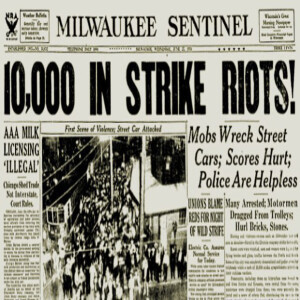
On this day in labor history, the year was 1934.
That was the day 1400 workers at the Milwaukee Electric Railway and Light Company launched a four-day strike.
Three unions, representing about a third of the total employees, were fighting to break the hold of the company union.
The transit and power company had already fired 13 workers for union activity.
IBEW, Operating Engineers and the Amalgamated Association of Street and Electric Railway Employees unions led the walkout.
They demanded reinstatement of their fired coworkers.
They also wanted the right to pick their own bargaining representatives and insisted the company union rescind its policy of barring strikers from membership and further employment.
The walkout began early that morning as strikers surrounded car barns, garages and power plants.
Company agents barricaded facilities with barbed wire, supplied Pullman cars for strikebreakers and posted armed guards on streetcars.
Almost immediately, striker Joseph Urbanski was mowed down and seriously injured as he tried to stop a scab streetcar.
By nightfall, 5,000 strikers and their supporters had blocked five transit lines.
They ripped protective screens from streetcar windows and forced scab drivers to abandon their routes.
As crowds swelled to 10,000 on the second day of the strike, a little more than half of all cars were in service.
More than 100 streetcars had been damaged.
Socialist Mayor Daniel Hoan placed the blame squarely on the utility company.
Street battles with police and scabs continued into the third day of the strike.
Milwaukee’s Federated Trades and Building Trades Councils threatened a general strike in the city by July 2 if the strike was not settled.
By June 30, workers celebrated total victory when the company conceded to all of their demands.
More Episodes
 2024-11-06
2024-11-06
 2024-11-05
2024-11-05
 2024-11-04
2024-11-04
 2024-11-03
2024-11-03
 2024-11-02
2024-11-02
 2024-11-01
2024-11-01
 2024-11-01
2024-11-01
 2024-11-01
2024-11-01
 2024-11-01
2024-11-01
 2024-11-01
2024-11-01
 2024-11-01
2024-11-01
 2024-10-21
2024-10-21
 2024-10-18
2024-10-18
Create your
podcast in
minutes
- Full-featured podcast site
- Unlimited storage and bandwidth
- Comprehensive podcast stats
- Distribute to Apple Podcasts, Spotify, and more
- Make money with your podcast
It is Free
- Privacy Policy
- Cookie Policy
- Terms of Use
- Consent Preferences
- Copyright © 2015-2024 Podbean.com




